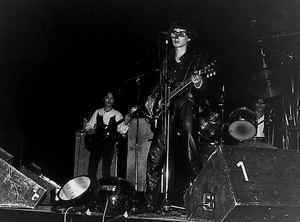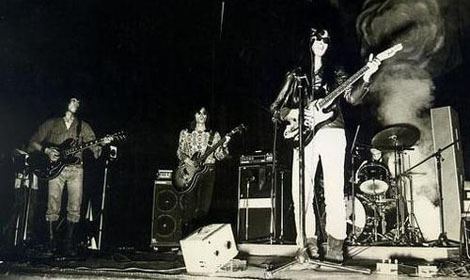Also known as 裸のラリーズ Origin Japan (1967) | Years active 1967–1996 | |
 | ||
Associated acts Fujio Yamaguchi, Taj Mahal Travellers, Acid Seven, Masato Minami, Arthur Doyle, Shizuka, Suishou no Fune Past members Takashi MizutaniTakashi KatoTakashi TadaMoriaki WakabayashiTakeda KiyohiroTsutomu MatsumotoTakeshi NakamuraShunichiro ShodaHiroshi NarFujio YamaguchiToshirou MimakiMakoto KubotaDoronco GumoMikio NagataMaki Miura Members Takashi Mizutani, Fujio Yamaguchi, Makoto Kubota Albums Heavier Than A Death In, '77 Live, Cable Hogue Soundtrack, Mizutani, Oz Days Live | ||
Les rallizes d nud s enter the mirror
Les Rallizes Dénudés (裸のラリーズ, Hadaka no Rallizes) were a Japanese rock band. They originally began in 1962 as a musical theatre troupe, however the formation of the band was not until 1967 at Kyoto University. The band's style is typified by simple, repetitious instrumental passages, shrieking, cacophonous guitar feedback and folk arrangement. Their discography is made up mostly of live bootlegs, soundboard archives and even a few rare aborted studio recording attempts as they have never officially released any of their own material, although there are archive releases on independent labels such as Univive, Rivista, Phoenix and Banzai.
Contents
- Les rallizes d nud s enter the mirror
- Les rallizes d nud s night of the assassins
- History
- Select Discography
- Songs
- References

Les rallizes d nud s night of the assassins
History

Much of Les Rallizes Dénudés' history remains largely shrouded in mystery and nearly nothing is known about their highly enigmatic frontman Takashi Mizutani. A few very sparse first person accounts and documentation describe Mizutani as an extremely introverted and reclusive individual with very nihilistic and solipsistic views on life. It is also evident that he had very radical leftist views and supported the Japanese Red Army.

Les Rallizes Dénudés emerged from the late 60's underground rock scene that was forming in the Kyoto commune scene. Other notable groups to emerge from this scene were The Taj Mahal Travellers, The Ubiquitous Acid 7 group and Masato Minami. Les Rallizes Dénudés and The Taj Mahal Travellers are often seen as well ahead of their contemporaries at the time and far more original and innovative, as their styles were not largely utilized in the underground rock and psychedelic scenes yet.

The earliest recordings of Les Rallizes Dénudés date back to an aborted studio session recorded some time in either late 1967 or early 1968. Supposedly, Mizutani was so dissatisfied with the sound of the recordings that he decided to completely abandon the idea of recording studio material. After that point, he made very rare studio visits making another unsuccessful studio recording attempt in 1980. Some of the more notable recordings from the 1967-68 recording are "Otherwise My Conviction" and another track which roughly translates to either "Birdsong" or "Cry of a Bird". The latter of the two recordings was recycled often in their live sets. Later in 1968 they performed a live track that has gained some recognition as their first real foray into noise, the nearly 20 minute long "Smokin Cigarette Blues". Although poorly recorded, the recorded is considered to be very important in the development of noise rock.

Their Live performances originally accompanied performances by avant-garde theater groups (such as Shuji Terayama's troupe). Their performances were quickly deemed too loud and intense to back a theater performance, as it would be too distracting. One of their earliest and most infamous concerts was a concert at a Kyoto Kyoto University during the student protests that were going on at the time. This particular concert was dubbed "Barricades-A-Go-Go". A posthumous compilation entitles "'67-'69 Studio Et Live" contains a recording of a live performance which may have been from that event.
Mizutani was a known fan of The Velvet Underground and took influence from their second album White Light/White Heat in order to craft his own sound for his band.
In 1970, the original bass player Moriaki Wakabayashi assisted in the hijacking of Japan Airlines Flight 351 orchestrated by the Japanese Red Army. Wakabayashi has been living in North Korea since the hijacking. Mizutani was allegedly offered a role in the hijacking, but turned it down. After this event, however, a paranoid Mizutani kept a low profile due to his ties with the Red Army, which he supposedly would eventually cut ties with in the early to mid 70's to avoid government scrutiny, although it remains unknown if he was ever affiliated with the Red Army at all.
In 1973 they would appear on a limited edition live compilation "Oz Days Live", which was one of only two released recordings by the group that documented their current sound at the time (the other being "Eve Night" from 1983). 1977 to 1982 is considered by most to be their prime, as their most well received recording is of a live performance from 1977.
In the early 80's there was a drastic change in sound within the band as Mizutani had hired more musically competent musicians and replaced the rhythm guitarist with second lead guitarist Fujio Yamaguchi, whose much more bluesy and melodic delivery added tone color to the group that hadn't been heard before. This time period is documented on "Double Heads", a comprehensive six-disc box set that documents three separate concerts from 1980 to 1981. In mid 1981 Yamaguchi left the group which was now downsized to a trio, which they would stay for the most part until they would break up in 1996. At this point their sound was much more sparse and atonal, as the bass was the sole melodic instrument in the group. Their mid 80's to mid 90's sound bears many similarities to Ornette Coleman's mid 60's work with his trio. After 1987, for unknown reasons, their performances became much more sparse with most of their available 90's recordings and film footage originating from 1993, 1994 and 1996.
Their final concert was arranged under heavy secrecy, with the reason for breaking up could possibly have been legal reasons due to Mizutani's alleged past involvement with the Red Army. The last time any know band member had been seen in public, with the exception of former guitarist Fujio Yamaguchi (deceased) and former bassist Doronco Gumo, was in 1997 when Mizutani performed a live free jazz concert with Saxophonist Arthur Doyle and drummer Sabu Toyozumi, although an unknown source claimed to have seen him sometime after the date of the concert in France. Mizutani has likely at least been alive up to 2011 due to his supposed approval of the Banzai released "Naked Diza Star" box set. It is unknown what his whereabouts are since his disappearance in 1997 or if he is still alive.
Les Rallizes Dénudés' influence likely started in the mid 70's when Keiji Haino and his band Lost Aaraaff would often play at concerts with them. Les Rallizes Dénudés can be seen as a heavy influence of Haino's later group, Fushitsusha. Fushitsusha took many of the elements from Mizutani's group and furthered them in many ways, such as incorporating more freeform group improvisation. The mid to late 70's underground scene that Les Rallizes Dénudés was a part of could be seen as responsible for the explosion of psychedelic and noise music that occurred in Japan in the 80's and 90's that featured more well known acts like The Boredoms, Merzbow, Hanatarash, Boris, Melt Banana, High Rise and Acid Mothers Temple. Les Rallizes Dénudés was also seen as an early forerunner to shoegaze, punk rock and alternative folk.
Select Discography
Songs
夜、暗殺者の夜'77 Live · 1991
Enter The Mirror'77 Live · 1991
White WakingCaress & Violence · 1987
